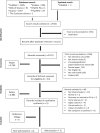Effectiveness of computer-aided learning in oral health among patients and caregivers: a systematic review
- PMID: 27274013
- PMCID: PMC7654076
- DOI: 10.1093/jamia/ocw045
Effectiveness of computer-aided learning in oral health among patients and caregivers: a systematic review
Abstract
Computer-aided learning (CAL) offers enormous potential in disseminating oral health care information to patients and caregivers. The effectiveness of CAL, however, remains unclear.
Objectives: The purpose of this study was to systematically review published evidence on the effectiveness of CAL in disseminating oral health care information to patients and caregivers.
Materials and methods: A structured comprehensive search was undertaken among 7 electronic databases (PUBMED, CINAHL Plus, EMBASE, SCOPUS, WEB of SCIENCE, the Cochrane Library, and PsycINFO) to identify relevant studies. Randomized controlled trials (RCTs) and observational studies were included in this review. Papers were screened by 2 independent reviewers, and studies that met the inclusion criteria were selected for further assessment.
Results: A total of 2915 papers were screened, and full texts of 53 potentially relevant papers (κ = 0.885) were retrieved. A total of 5 studies that met the inclusion criteria (1 RCT, 1 quasi-experimental study, and 3 post-intervention studies) were identified. Outcome measures included knowledge, attitude, behavior, and oral health. Significant improvements in clinical oral health parameters (P < .05) and knowledge/attitudes (P < .001) were reported in 2 of the studies. The 3 remaining studies reported improved oral health behaviors and confidence.
Conclusion: There is a limited number of studies which have examined the effectiveness of CAL interventions for oral health care among patients and caregivers. Synthesis of the data suggests that CAL has positive impacts on knowledge, attitude, behavior, and oral health. Further high- quality studies on the effectiveness of CAL in promoting oral health are warranted.
Keywords: caregivers; computer-aided learning; oral health care; patients.
© The Author 2016. Published by Oxford University Press on behalf of the American Medical Informatics Association. All rights reserved. For Permissions, please email: journals.permissions@oup.com.
Figures
Similar articles
-
A rapid and systematic review of the clinical effectiveness and cost-effectiveness of topotecan for ovarian cancer.Health Technol Assess. 2001;5(28):1-110. doi: 10.3310/hta5280. Health Technol Assess. 2001. PMID: 11701100
-
Strategies for enhancing the implementation of school-based policies or practices targeting risk factors for chronic disease.Cochrane Database Syst Rev. 2017 Nov 29;11(11):CD011677. doi: 10.1002/14651858.CD011677.pub2. Cochrane Database Syst Rev. 2017. Update in: Cochrane Database Syst Rev. 2022 Aug 29;8:CD011677. doi: 10.1002/14651858.CD011677.pub3. PMID: 29185627 Free PMC article. Updated.
-
The educational effects of portfolios on undergraduate student learning: a Best Evidence Medical Education (BEME) systematic review. BEME Guide No. 11.Med Teach. 2009 Apr;31(4):282-98. doi: 10.1080/01421590902889897. Med Teach. 2009. PMID: 19404891
-
Interventions for promoting habitual exercise in people living with and beyond cancer.Cochrane Database Syst Rev. 2018 Sep 19;9(9):CD010192. doi: 10.1002/14651858.CD010192.pub3. Cochrane Database Syst Rev. 2018. PMID: 30229557 Free PMC article.
-
Comparison of the effectiveness of inhaler devices in asthma and chronic obstructive airways disease: a systematic review of the literature.Health Technol Assess. 2001;5(26):1-149. doi: 10.3310/hta5260. Health Technol Assess. 2001. PMID: 11701099
Cited by
-
Effectiveness of a Web-Based Health Education Program to Promote Oral Hygiene Care Among Stroke Survivors: Randomized Controlled Trial.J Med Internet Res. 2017 Mar 31;19(3):e87. doi: 10.2196/jmir.7024. J Med Internet Res. 2017. PMID: 28363880 Free PMC article. Clinical Trial.
-
Physicians' and Patients' Expectations From Digital Agents for Consultations: Interview Study Among Physicians and Patients.JMIR Hum Factors. 2024 Mar 18;11:e49647. doi: 10.2196/49647. JMIR Hum Factors. 2024. PMID: 38498022 Free PMC article.
-
Effectiveness of e-learning to promote oral health education: A systematic review and meta-analysis.Medicine (Baltimore). 2023 Dec 22;102(51):e36550. doi: 10.1097/MD.0000000000036550. Medicine (Baltimore). 2023. PMID: 38134063 Free PMC article.
-
Integrated Digital Patient Education at the Bedside for Patients with Chronic Conditions: Observational Study.JMIR Mhealth Uhealth. 2020 Dec 22;8(12):e22947. doi: 10.2196/22947. JMIR Mhealth Uhealth. 2020. PMID: 33350961 Free PMC article.
-
Effectiveness of Oral Hygiene Instructions Given in Computer-Assisted Format versus a Self-Care Instructor.Dent J (Basel). 2018 Jan 10;6(1):2. doi: 10.3390/dj6010002. Dent J (Basel). 2018. PMID: 29563403 Free PMC article.
References
-
- Schou L. Oral health promotion at worksites. Int Dental J. 1989;39: 122–128. - PubMed
-
- Eadie DR, Schou L. An exploratory study of barriers to promoting oral hygiene through carers of elderly people. Commun Dental Health. 1992;9: 343–348. - PubMed
-
- Kay E, Locker D. A systematic review of the effectiveness of health promotion aimed at improving oral health. Commun Dental Health. 1998;15: 132–144. - PubMed
-
- Kay EJ, Locker D. Is dental health education effective? A systematic review of current evidence. Commun Dentistry Oral Epidemiol. 1996;24: 231–235. - PubMed
-
- Daunt LA, Umeonusulu PI, Gladman JR, et al. Undergraduate teaching in geriatric medicine using computer-aided learning improves student performance in examinations. Age Ageing. 2013;42: 541–544. - PubMed
Publication types
MeSH terms
LinkOut - more resources
Full Text Sources
Other Literature Sources
Medical
Miscellaneous


